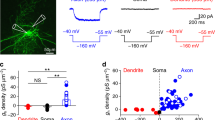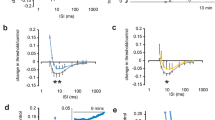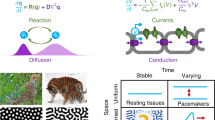Abstract
IN perfusion experiments with squid giant axons, the internal potassium concentration Ki can be reduced either by substitution of other univalent ions, so that both ionic strength si and osmolality are kept constant, or by dilution with non-electrolytes at constant osmolality. The importance of non-electrolyte perfusion in testing various models of resting potential difference (p.d.) and action potential is emphasized by the fact that there is a large range of resting potential difference (between − 25 and 0 mV) obtained by reducing Ki, in which action potentials are abolished if Ki alone has been reduced but are still obtained if si has been reduced proportionately1,2. For brevity, we shall call this the conditional range of potential difference. We can envisage various mechanisms by which lowering a high electric field across the axonal membrane can influence ionic permeabilities; all such possibilities would be lost if action potentials could still be obtained by depolarization of a low field. In order to maintain a high field across the membrane, even when the measured potential difference between inner and outer solutions is reduced by dilution of Ki with non-electrolyte, Hodgkin and Chandler3,4 introduced the new assumption that the inner surface of the membrane binds about thirty times more negative charges than are needed merely to terminate the membrane field. In this communication we propose, as an alternative, that on dilution of internal Ki with non-electrolyte, the membrane field becomes non-uniform in accord with the Planck electrodiffusion model5. The field at the inner surface of the membrane remains high even when the overall potential difference is drastically decreased by perfusion with solutions of low Ki and si.
This is a preview of subscription content, access via your institution
Access options
Subscribe to this journal
Receive 51 print issues and online access
$199.00 per year
only $3.90 per issue
Buy this article
- Purchase on Springer Link
- Instant access to full article PDF
Prices may be subject to local taxes which are calculated during checkout
Similar content being viewed by others
References
Narahashi, T., J. Physiol., 169, 91 (1963).
Chandler, W. K., and Meves, H., Arch. Ges. Physiol., 281, 25 (1964).
Hodgkin, A. L., and Chandler, W. K., J. Gen. Physiol., 48, No. 5, Part 2, 27 (1965).
Chandler, W. K., Hodgkin, A. L., and Meves, H., J. Physiol., 180, 821 (1965).
Planck, M., Ann. Physik. Chem., 39, 161 (1890).
Hodgkin, A. L., The Conduction of the Nervous Impulse (Liverpool University Press, 1964).
Bass, L., Trans. Faraday Soc., 60, 1914 (1964).
Hagiwara, S., and Tasaki, I., J. Gen. Physiol., 27, 859 (1957).
Goldman, D. E., J. Gen. Physiol., 27, 37 (1943).
Narahashi, T., J. Gen. Physiol., 48, No. 5, Part 2, 19 (1965).
Tasaki, I., Singer, I., and Takenaka, T., J. Gen. Physiol., 48, 1098 (1965).
Bass, L., and Moore, W. J., Proc. Australian Physiol. Soc. (abstracts of Ninth Meeting, August, 1966).
Author information
Authors and Affiliations
Rights and permissions
About this article
Cite this article
BASS, L., MOORE, W. Electric Fields in Perfused Nerves. Nature 214, 393–394 (1967). https://doi.org/10.1038/214393a0
Issue Date:
DOI: https://doi.org/10.1038/214393a0
This article is cited by
-
Moving boundary problems for the Harry Dym equation and its reciprocal associates
Zeitschrift für angewandte Mathematik und Physik (2015)
-
The electromechanochemical model of mitochondrial structure and function
Journal of Bioenergetics (1972)
-
The cation permeability of erythrocytes in low ionic strength media of various tonicities
The Journal of Membrane Biology (1969)
-
Biologic significance of piezoelectricity
Calcified Tissue Research (1967)
Comments
By submitting a comment you agree to abide by our Terms and Community Guidelines. If you find something abusive or that does not comply with our terms or guidelines please flag it as inappropriate.



